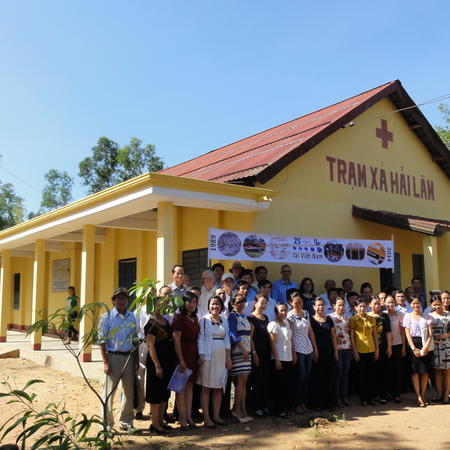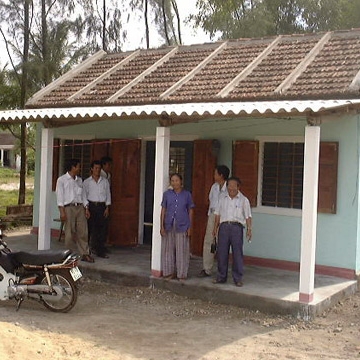- English
- Français
- Tiếng Việt
Housing losses cost more
Over recent years the renewal of housing stock has increased vulnerability to loss
Twenty five years ago, the typical situation for villages in the centre of Viet Nam was a cluster of houses with thatched roofs, a pole or bamboo frame, and bamboo mat walls. Most materials came from the locality, and many of these could be gathered. Capital investment in the home was extremely low and few if any of the inputs were monetary although families have always set social importance on getting, if they can, a good timber roof frame.
Although many houses were frail and easily destroyed by typhoons, recovery could be achieved at relatively low cost and depended significantly on family and neighbour support. Once the immediate effects of a typhoon had subsided, village reconstruction took place quickly and at low cost and relatively little disruption to the pattern of life.
But by the mid 1980’s change was taking place. Families began improving their homes. Frequently, the first step was to replace the thatch roof with cement or ceramic tiles. This new and expensive roof invariably rested on a frail supporting structure. Today, many houses still have a mixture of materials, from concrete and tiles through to bamboo matting, all in one structure. The result has rarely been very resistant.
There have been other changes in building practice. Typhoon resistant features were habitually included in most "traditional" types of building to hold down roofs and secure the structure. With the change to new materials, typhoon resistant techniques have been largely omitted in buildings constructed with ‘modern’ materials – in effect, whilst many of the techniques exist in the community they have ceased to be systematically applied. Given that many techniques exist in the community, a paradox is that families interviewed* often claim that they do not know how to make their house stronger and safer. There would appear to be two additional reasons for this: firstly to achieve savings, and secondly the mistaken belief that these materials are inherently more typhoon resistant. The risk of damage is compounded because many houses are built incrementally and are often in an only partially completed state for long periods. Overall, as investment in improvement increases there has also in effect been more that is at risk of loss.
Typically, a family with a monthly income of between 20 and 35 US $ has a main house (not including the kitchen, veranda and any annexes)* with a floor area of 35m² (5x7 m) and a terrace (2x7 m), which represents an investment (in effort and money) of between 750 and 1000 US $. The families often make their own cement tiles and blocks and collect sand and gravel. But they will buy many other materials including cement, steel bars, ceramic roof tiles, doors and windows. And although help from the family and neighbours is important, many families also borrow money to cover these building costs.
Overall, in the past fifteen years there has been a massive amount of private investment in building in rural Viet Nam. Visual estimates by DW Viet Nam team – many houses have a date on them - suggest that more than 70% of provincial and rural housing in Central Viet Nam has been replaced or renewed over this period.
Commune by commune, the investment in housing over this period amounts to a very considerable amount. Taking a sample of 10 communes in Thua Thien Hué province with an average of 16 000 families where DW has been working, over the past 15 years one can estimate that the capital investment for 70% of the communes families, at a conservative value of 800 US $/house, totals over 9 million US $. Commune surveys in Thua Thien Hué also indicate that despite this investment in new building, about 70% of this housing stock can only be classified as ‘semi-solid’ or weaker, and thus very vulnerable to damage.
Today, when a storm occurs, damage to houses costs much more to repair, and such loss has an economic and physical impact on a family and its health. Loss of roof tiles (a frequent occurrence in a typhoon) costs some 115 US $ to replace; loss of the whole house requires many hundreds of US $ .
Prevention is cheaper than reconstruction:
Compared to the risk and cost of losing ones home, the DW experience of working with families in Thua Thien Hué Province since 1999 has showed that, for an average house value of 975 US $ for 35m², an extra maximum of 25% - 250 US $ - needs to be spent on making the building flood or typhoon resistant, and for many houses the cost is less. The result: a resistant house where the preventive strengthening investment ranges from 15 to 30% of the total final cost. The same applies to a small school, health centre or market.
Failure to take preventive action to ensure that such damage does not occur has the effect of diverting money away from economic growth, and family security and health
Sources
Lam Ngoc Mai, July 2001, and Tran Minh Chau, "Études de cas des familles bénéficiaires du projet" DW & ENDA, Hué, 2001.
DW VN – database on house, improvement and strengthening costs











